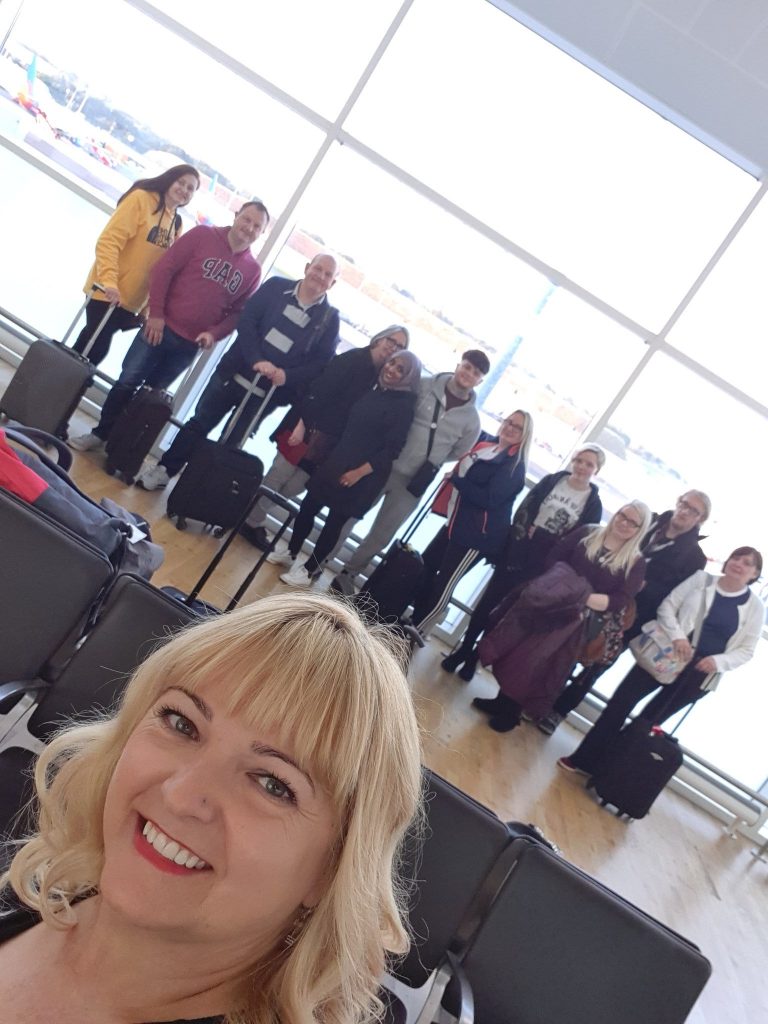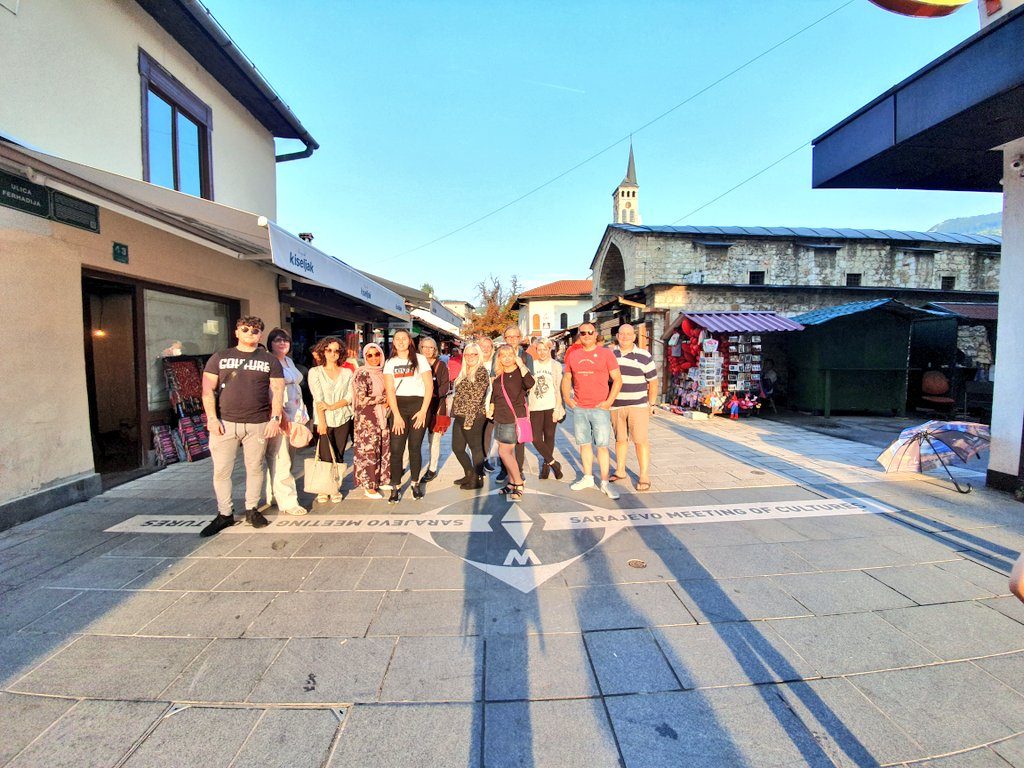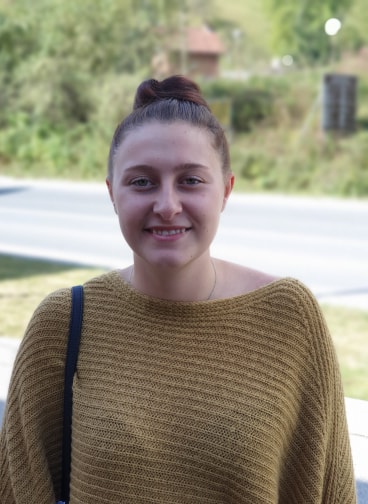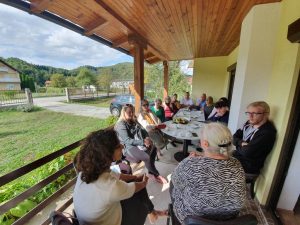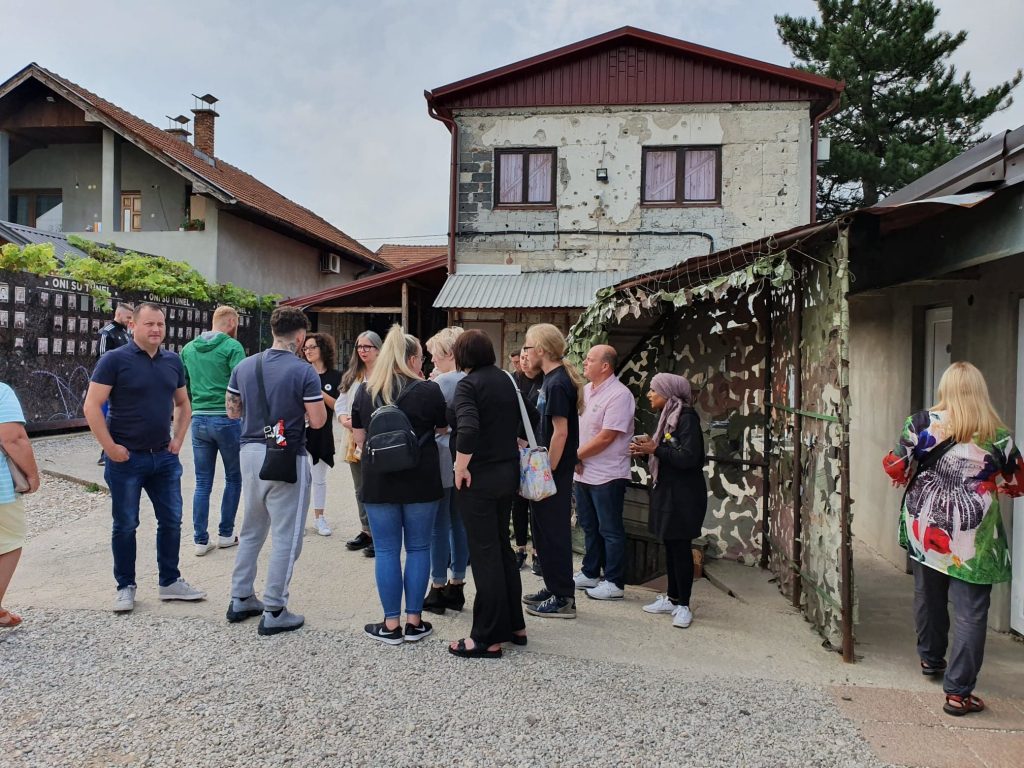Read the first-hand testaments from the team out in Srebrenica, Bosnia.
Srebrenica 2019
Discovering Srebrenica – Day 1
Bosnia and Herzegovina greeted us with sunshine, green hills, buildings and architecture new and old, crowds of people, buzzing restaurants, a vibrant city decorated with cute little shops. We were delighted with our hotel, Novotel Bristol. We checked into our rooms within an hour of landing in
Sarajevo, the vibrant capital city where east meets west.
I liked how interested the group was, they were really enjoying themselves, eager to learn about the country, its culture and its people. After their first taste of traditional Bosnian food, everybody was ready for their first history lesson. The evidence of war was visible on almost every building, on every street around the city.
Monuments dedicated to the 13,952 Sarajevo citizens that were killed were dotted on every corner, these monuments also represented 5434 civilians and 1500 children. The monuments stood to honour the needless loss of so many lives, regardless of their age, sex or background. The tears that were visible in the eyes, the shaking of heads, the deep intakes of breath, told me how emotional and moved everybody in the group was.
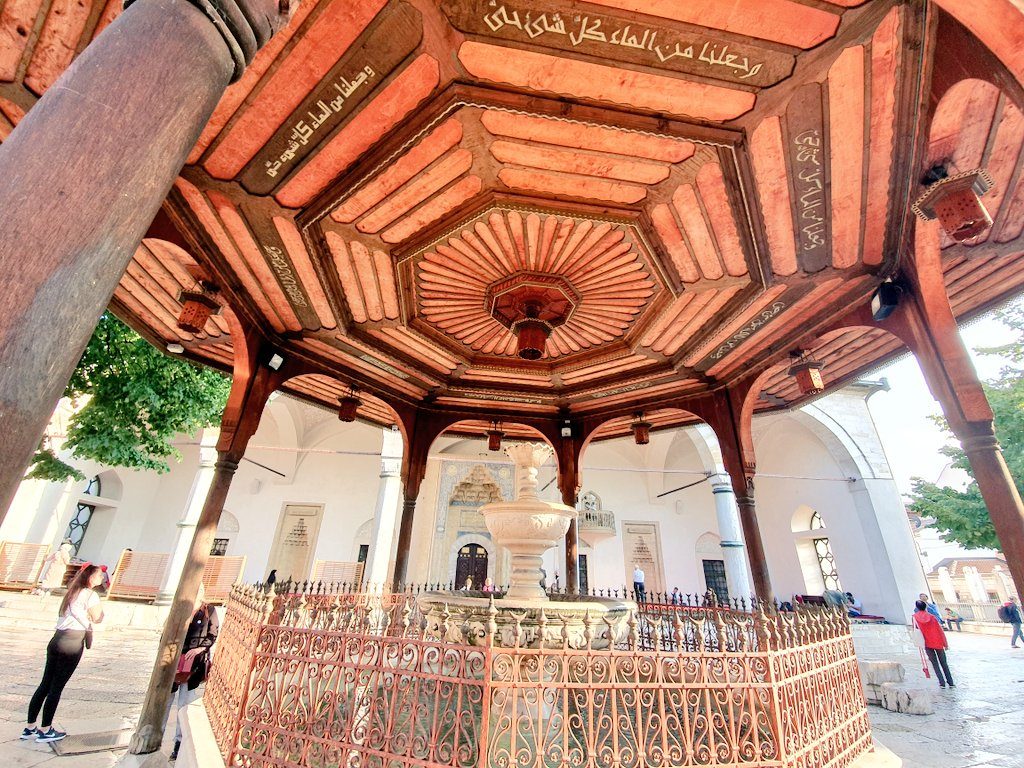 By the end of Day 1 in Bosnia, the whole group bonded beyond repair.
By the end of Day 1 in Bosnia, the whole group bonded beyond repair.
Over a coffee, nearing the end of the day, everyone was showing and talking of gratitude for the opportunity to learn and discover the events that happened here during the 1992-95 war in Bosnia, they were eager to see more.
Elmina, our tour guide, was just 7 years old when the war started, she spent 5 weeks in a concentration camp in the Prijedor region (North-West of Bosnia and Herzegovina), a place where people were systematically gathered, tortured, raped and killed. Prijedor is the area that commemorated the atrocities with White Armband Day.
Tomorrow, we visit Srebrenica…
- Aida
Srebrenica 2019
Discovering Srebrenica – Day 1
Today has been quite an emotional journey. When on arrival in Bosnia, we took a short journey into Sarajevo were we started to walk around the town. First glances, we saw a mixture of the old and new building, the cross between the modern era of urbanisation and the real history of what happened.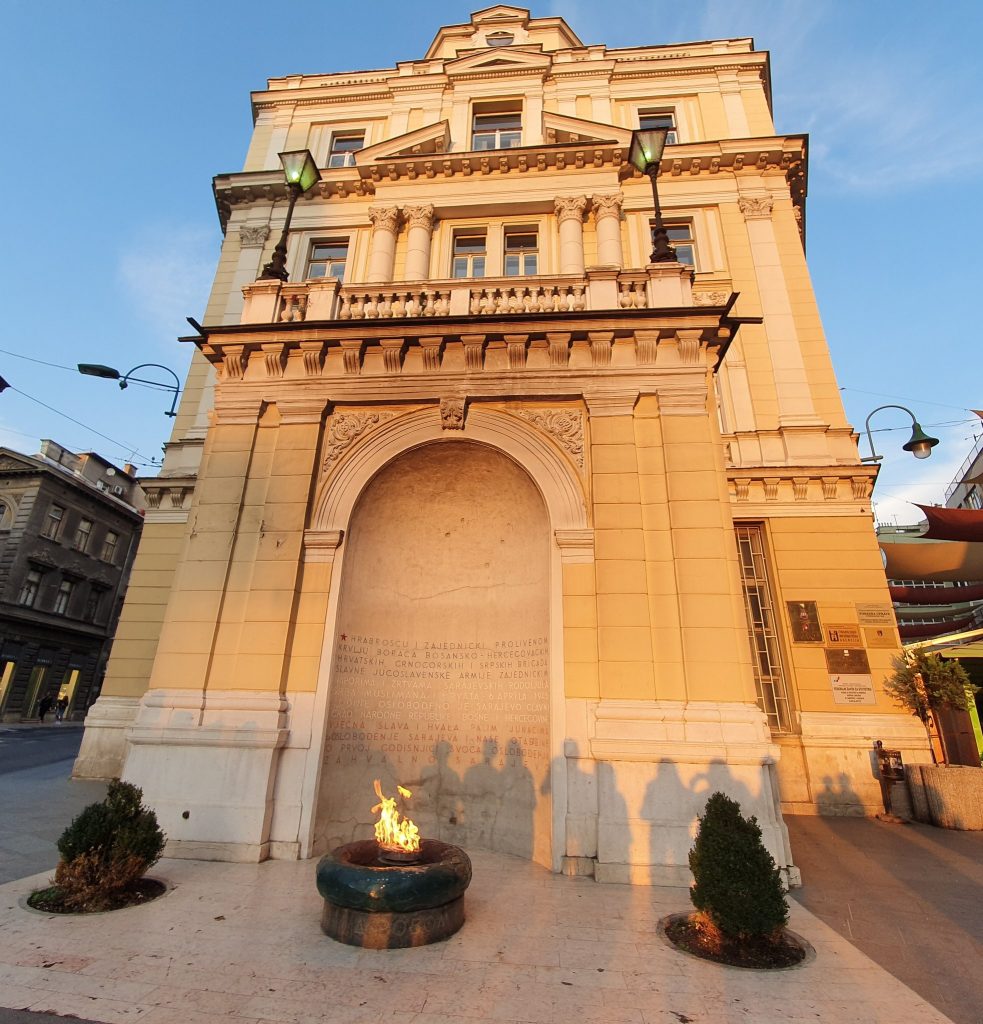
Taking a closer look at the buildings, evidence of shrapnel and bullet holes can be seen, this was devastating to see as we were so close within the city. It is interesting to find that what happened years ago can still be seen throughout and that the history and the pain have not just been swept underneath the carpet for people to forget. Outside the Catholic Cathedral, the first insight of were Serajevo is placed within the bottom of a valley hit home. 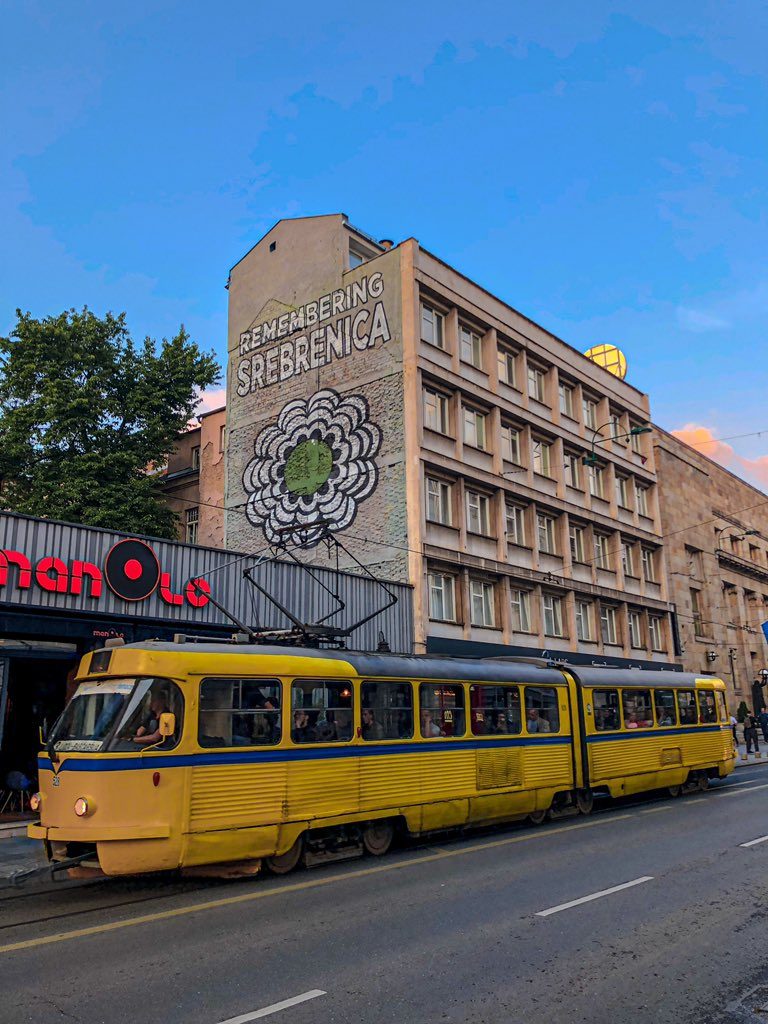
Our tour guide explained to us that innocent civilians, including children, were targeted from the valley mountains with snipers, which left many dead and afraid to even venture outside. Evidence of shell dropping remains here, was evidence of painted roses can be found surrounding the area of destruction. Looking at these memorials makes you realise how close within the city this happened, however, you still couldn’t imagine this tragic war taking place against innocent communities. We learnt that a ‘peace day’ in Feb 1994 took place, however, there was nothing peaceful about this. In a small market, the same memorial of the roses around the explosion was found.
Hundreds of innocent lives were lost in a massacre that took place within this small market area, where people should have felt safe and been allowed to go out and buy necessities without being under prejudice. 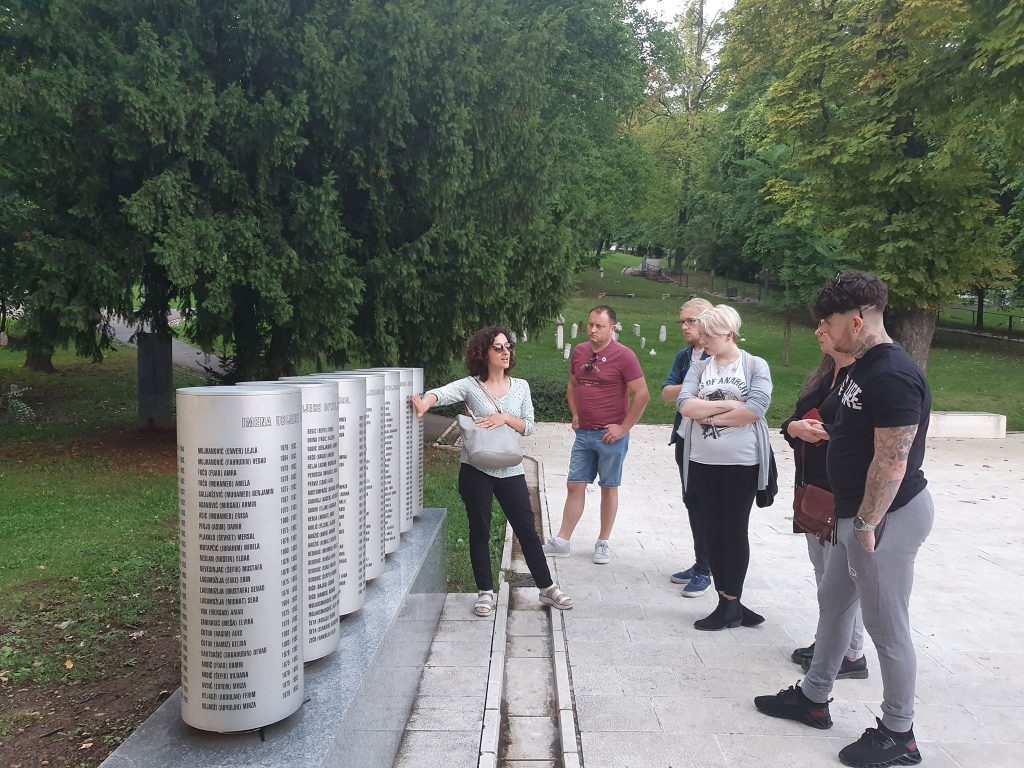
Today we see in Sarajevo a mixture of past and present, a closer community with different religions. Memorials are dotted around the city in commemoration of the lives that were lost and the people that have lost loved ones. Towards the end of the day, we were taken to the children’s memorial, where over 1000 were lost within the siege between 1992 and 1995. We are also expecting an emotional day tomorrow when we visit the survivors of the Srebrenica genocide.
- Katie
Srebrenica 2019
Discovering Srebrenica – Day 2
Today started early with everyone on the bus at 8.00am. The sun was already shining brightly and it promised to be another beautiful day in Bosnia. A delightful packed lunch full of goodies, apples and nectarines, plum juice and water, sandwiches wrapped in tinfoil reminiscent of family trips to the seaside and the scrumptious apple pie, just like Aida makes ‘back-home’. There was a lovely atmosphere on the bus, smiles and laughter, but I knew, because I felt it, that inside of everyone, we were all thinking about the place where we going and the people, the mothers we would be meeting. How is it possible to prepare for this? The photographs of places and faces viewed from the safety of a screen would soon be replaced with real people, just like us, mothers just like me but not like me. My children had never been torn from my arms and murdered by other mother’s sons.
My thoughts are interrupted by a spontaneous lesson on how to wear your hijab, masterfully delivered by our own resident Imam Rukia. Not only skilled in the art of the hijab but also in putting it on whilst travelling at speed round corner and over bumps. It was so lovely and fun and expressed the idea of Islam in a warm and accessible manner.
Whilst on the bus we had an introduction to the day from our coordinator, Elmina. We came to understand that everyone at the memorial centre we were going to are all survivors and that the ‘Mothers of Srebrenica’ had dedicated their lives to finding their loved ones and fighting for ‘Truth and Justice’
They want us to know what happened, they want us to hear their stories, they want us to tell their stories and in doing so we can play our part. The introduction was followed by a pencil sketch political history lesson to the break-up of former Yugoslavia and the determined activities which led ultimately to the ethnic cleansing and genocides that took place across Bosnia.
Looking out of the window of the bus, I saw what a beautiful country Bosnia is, with its tree (so many of them!) mountains and rivers. It is lush and green and looks so peaceful. I thought of our countryside and our country our people and communities, it didn’t seem so different. I thought of the referendum in Yugoslavia, the dangling in front of peoples faces the mythical ideas of being ‘free and independent’ that somehow ‘standing alone and separate’ would make a ‘nation’ stronger, and I thought of our referendum and the same narratives of independence and being free from Europe and chants of ‘we want our country back’ and how easily peaceful nations can be turned to hated and conflict.
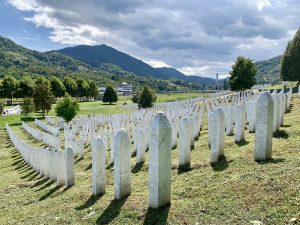 As we got closer to our destination our bus slowed so that we could look at a complex where boys and men and been taken, tortured and murdered. Amongst the beauty of the surrounding area it stood intact because of the on-going investigations, another ‘concrete memory’ I learned later that back in July when the mothers of the murdered have gone to pay their respect to their sons and lay flowers at the site they were prevented from doing so. Later some received fines from the ‘authorities’ essentially for trespass, fines of 800km.
As we got closer to our destination our bus slowed so that we could look at a complex where boys and men and been taken, tortured and murdered. Amongst the beauty of the surrounding area it stood intact because of the on-going investigations, another ‘concrete memory’ I learned later that back in July when the mothers of the murdered have gone to pay their respect to their sons and lay flowers at the site they were prevented from doing so. Later some received fines from the ‘authorities’ essentially for trespass, fines of 800km.
A little further along I saw come into sight white gravestones extending up the hillside too many to make sense of. Stark white and standing upright and proud. We had arrived at the memorial. Rukia had explained to us on the bus that she would recite some verses from the Koran at the memorial, the verses chose were a prayer for the mothers of the dead. The verses were melodic and eerie and her voice as quiet and gentle as it was filled the air. We had some time to walk through the memorials and look at the names…. So many names, so many families, how was it possible, how could I make sense of it. I looked for the names of people born in the same year as myself and my husband and my brother and sister. All of us still with our lives to lead, and the chances to see our kids grow strong and right. All of us with the right to laze in our gardens and share funny memories and make plans for all of our tomorrows.
We walked to the UN base where the Dutch Unit were placed in an area declared a ‘Safe Zone’ I remembered so clearly as we walked the perimeter fence to the entrance watching this ‘internal conflict’ as it was presented on the telly in my living room. I could hardly believe that I was walking in the same place as families 24 years ago had walked desperately for help and safety, whole families coming together, trusting that those in the blue-helmets will keep us safe; they didn’t… those in the blue-helmets trusting the UNITED NATIONS (let that sink in for a minute) trusting the UN to send air support as the VRS and Ratko Mladic attacked… the airstrikes never came.
We saw the film and heard testimony in the memorial centre, so many images were familiar to me as I recalled ‘that time’ covered by our own BBC. We heard first hand of the complete believe that ‘this war would not come to us’ But it did. We heard of orders given for families to present themselves in the town centre, and I found myself thinking about the ‘steps of genocide’ and the blueprint which I first came aware of studying the Holocaust. We heard of families holding on to each other, and a final precious letter from a father, telling his children to be good, be strong, and instructions on what they must do (to survive)
There was so much to hear, so much to take in, but let’s remember this is just the beginning of our journey and we must be determined to carry on the learning from this visit when we are back home!
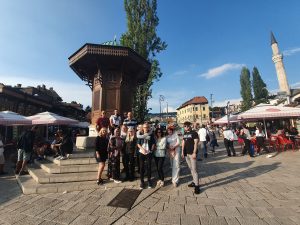 And the next place we went to was ‘home’ especially created and designed as a ‘typical Bosnian’ home, a place for the Mothers of Srebrenica to come together and support each other, to gather their strength. A base for their quest for Truth and Justice, a place where they could begin to tell their stories and make sure that the world knew what had happened here. We met Muneera who is actually and completely a legend. Warm and open and honest and giving. She told the story of the genocide. She was flickering and determined. She told us her story in a way which did not brutalise us but without shying away from the hurt. At times tears would come into her eyes, which were mirrored by all of us in her presence. Aida and Elmina showed on their faces the pain and sadness that they are still living with. In the end, a simple message came forward to teach our children to be kind and good. But I will finish with these words which cannot ever be changed. Muneera told us that ‘Every night I lay down in sadness and every morning I wake up in pain.
And the next place we went to was ‘home’ especially created and designed as a ‘typical Bosnian’ home, a place for the Mothers of Srebrenica to come together and support each other, to gather their strength. A base for their quest for Truth and Justice, a place where they could begin to tell their stories and make sure that the world knew what had happened here. We met Muneera who is actually and completely a legend. Warm and open and honest and giving. She told the story of the genocide. She was flickering and determined. She told us her story in a way which did not brutalise us but without shying away from the hurt. At times tears would come into her eyes, which were mirrored by all of us in her presence. Aida and Elmina showed on their faces the pain and sadness that they are still living with. In the end, a simple message came forward to teach our children to be kind and good. But I will finish with these words which cannot ever be changed. Muneera told us that ‘Every night I lay down in sadness and every morning I wake up in pain.
- Susan
Srebrenica 2019
Discovering Srebrenica – Day 3
The country is such a stunning place with astonishing views. It has such heartbreaking stories that touch your inner emotions and sentiments.
The thought of families being separated and torn apart is so sad. You can walk around and see where the bullets hit the buildings and even that thought is traumatising.
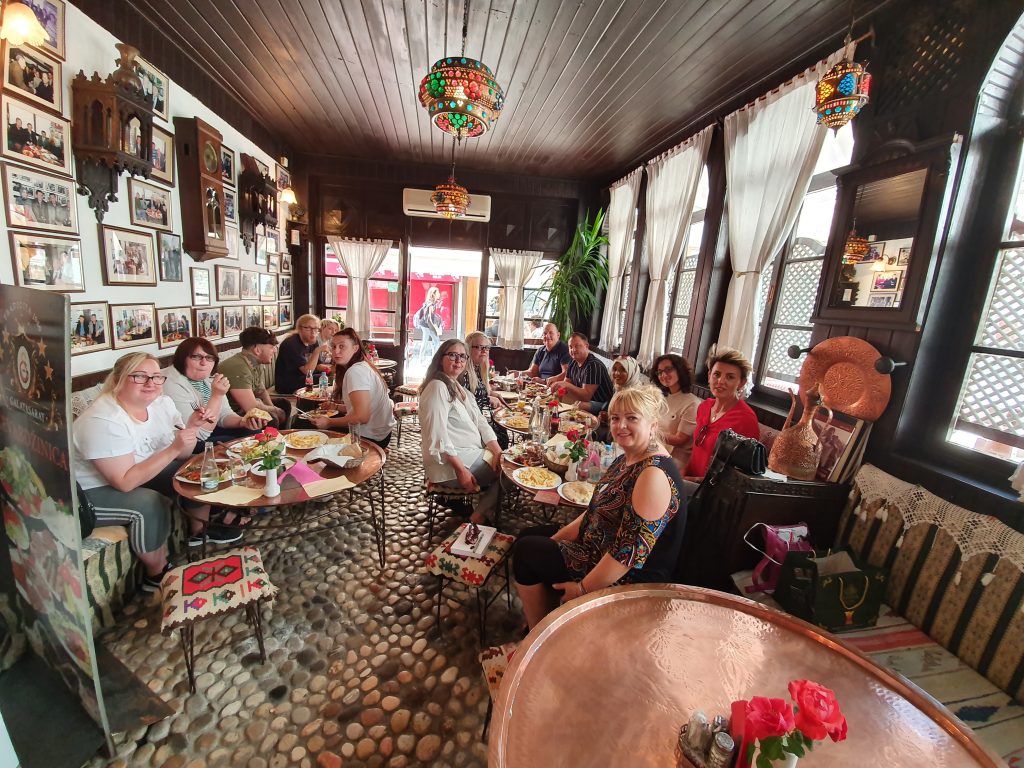 In order to know and feel some of the stories, you must visit the place and experience it yourself which I highly recommend.
In order to know and feel some of the stories, you must visit the place and experience it yourself which I highly recommend.
The most moving part of the journey for me was finding out about all the innocent children that were killed, there was over 1,000, the youngest being only one month old. I have a young child myself and hearing something like this makes me want to hold him close and never let go.
On day two we travelled to the city centre of Sarajevo and visited two museums, the first was called Valter Brani Sarajevo and the second was the War Childhood Museum. The first museum had weapons from World War II and also had dummies of Valter himself.
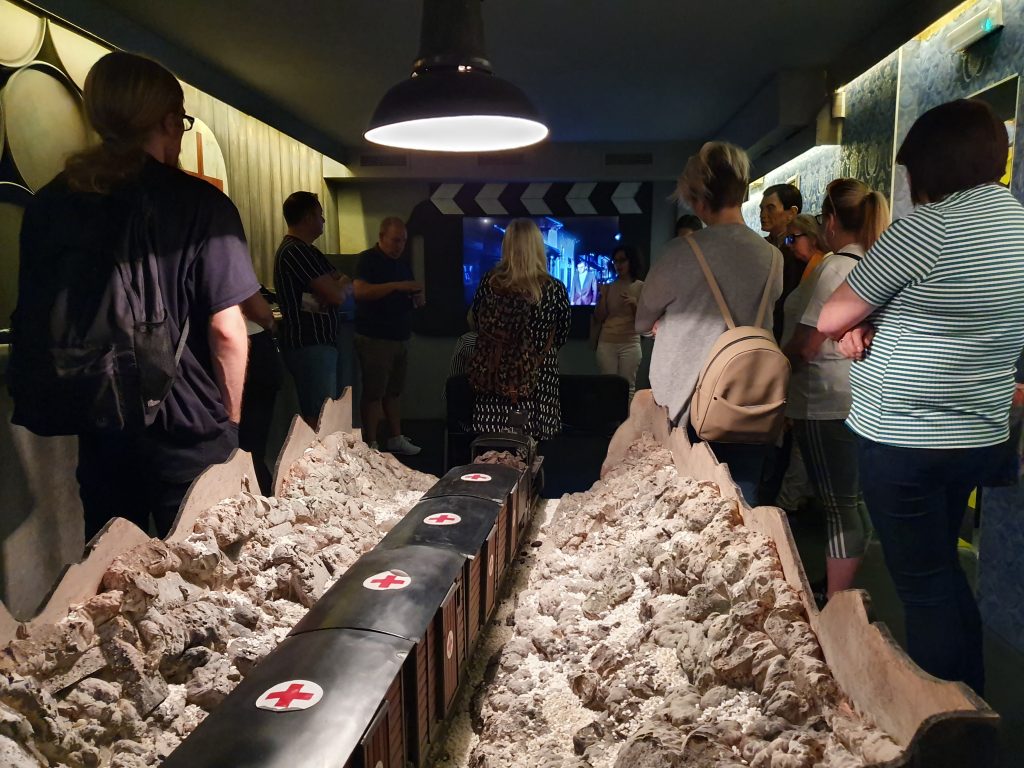 The War Childhood Museum was heavier than the other, it showed all the precious toys and games of the children that were affected by the Sarajevo genocide, each item had a story from the owner and how they received this item. It was touching and heartbreaking to read.
The War Childhood Museum was heavier than the other, it showed all the precious toys and games of the children that were affected by the Sarajevo genocide, each item had a story from the owner and how they received this item. It was touching and heartbreaking to read.
Once the museums were over we travelled on cable cars to the top of a mountain. This presented such beautiful views of the towns and city, it was great to see everybody enjoying themselves. I took many wonderful photos before going to the souvenir shops for loved ones.
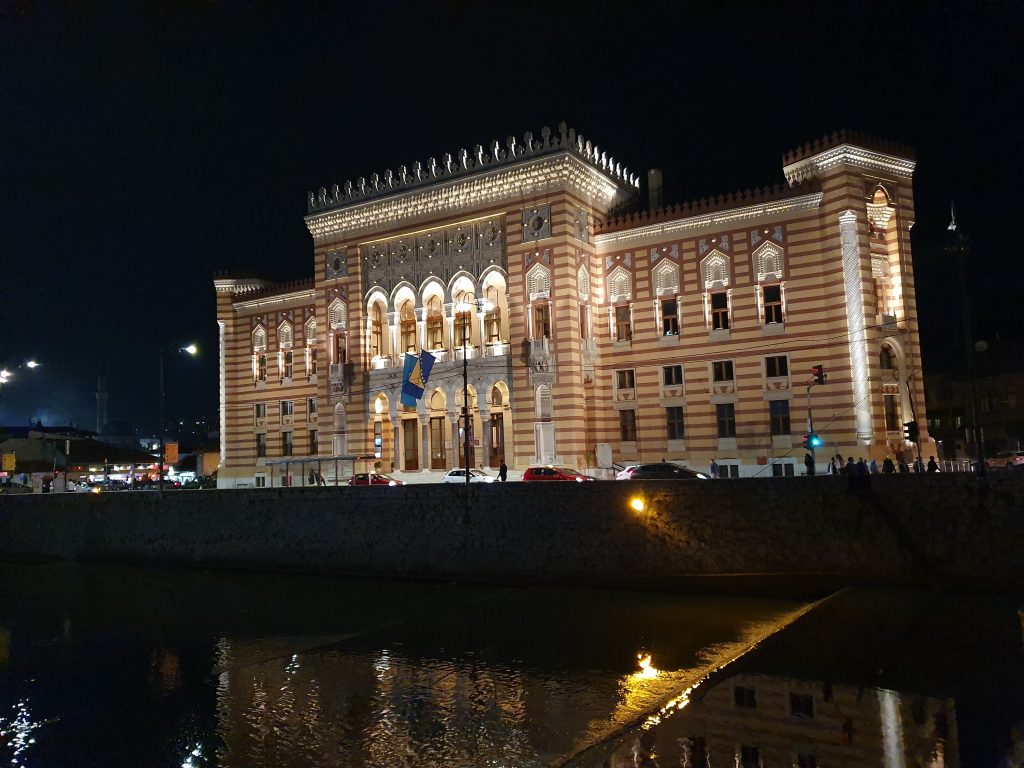 This trip has been a roller coaster, we all had laughs and tears. It’s such a shame to leave such a beautiful country.
This trip has been a roller coaster, we all had laughs and tears. It’s such a shame to leave such a beautiful country.
Srebrenica 2019
Discovering Srebrenica – Day 4
The day had arrived where we had to leave this beautiful country and return to our lives. Though returning had a different meaning all together now, we would be returning as different people. People carrying the reality and heartache of a massacre that took place against innocent civilians, due their identity.
We had checked out of our hotel but before making our way to the airport we had a crucial stop to make. We were to visit the Tunnel that lead to many Muslim Bosnians being freed from the hell on earth. This was the reality of Sarajevo.
Once we arrived, I noticed how the Tunnel area was very close to the airport. Upon entering the museum, we were welcomed by our guide. He himself was a neighbour to the tunnel both in the war and currently. He explained how the tunnel was constructed. He mentioned how the Bosnian Army began digging this in the depths of the night to minimise the risk of being caught, how they did not use any machinery to build it, as the Serb forces had the country under siege and were only stationed 5km away from them. This whole process took 4 months and 4 days. 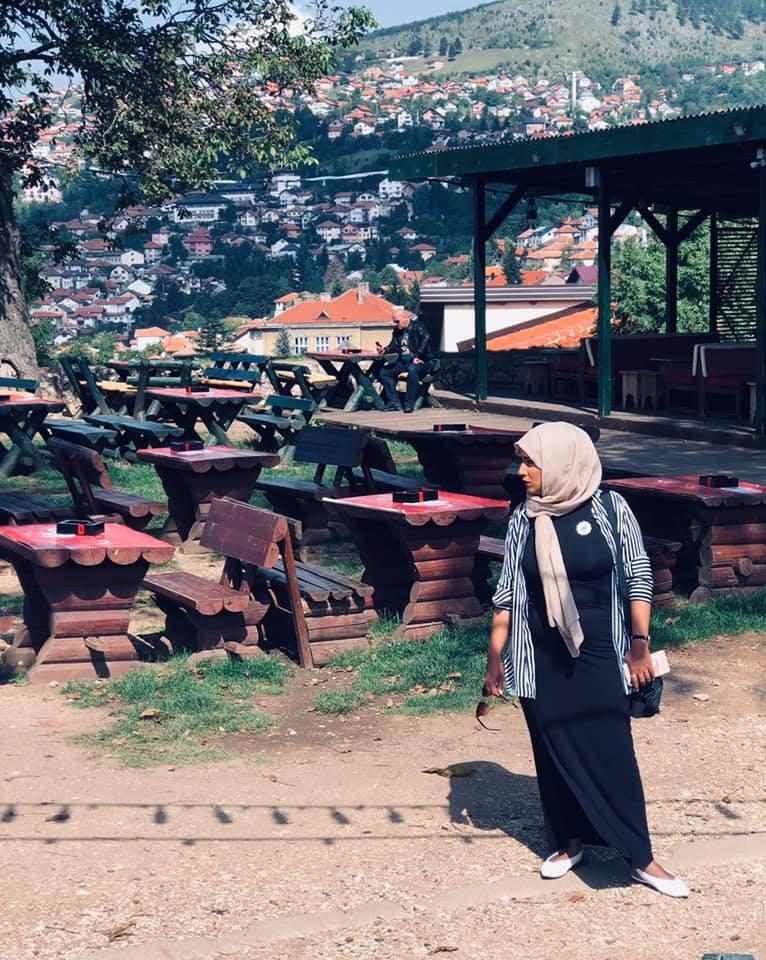
People began using this in the masses, to escape the siege and brutality of Sarajevo. My heart was sinking when we were told how the Serb forces found out and began killing all those entering the tunnel, creating a river of blood. I was trembling at the thought of being told that we must be conscious whilst walking in the tunnel, as in reality we will be walking on the blood of innocent people.
This statement hit hard and terrified my entire existence. Why was there so much merciless killing? What turned these people into monsters? Even whilst writing this there is a painful ache in my body.
These questions were running continuously in my head and something my husband said came to mind “if you were to understand why they did this and their thoughts whilst doing it then you would be just like them, you are human this is why you don’t understand’.
This mind set of monsters was confirmed again when the guide told us how one Serb soldier was asked whilst being tried for his crimes, why he did this and how did he have the heart to carry out such gruesome atrocities, he replied saying ‘he would be drinking alcohol and once he got bored he would stand and start shooting”.
My heart was quivering whist we made our way to experience the tunnel, that was used by frightened innocent people desperate to get to safety. The tunnel was long but very narrow and extremely claustrophobic. I am only 5’1 and I was having to bend entirely to walk through it. What must have they been feeling? How did they breathe? Safety and freedom was all they were thinking about.
This trip has really impacted my life and my view of the world. It has also reaffirmed the belief of how blessed I am, to lead the life I live, as well as my children and family. I have returned with a debt, a debt to the people who lost their lives for being Muslim and the mothers who lost their world. A debt to make the world aware of this awful reality with the vision to contribute to the understanding, that this should never happen again.
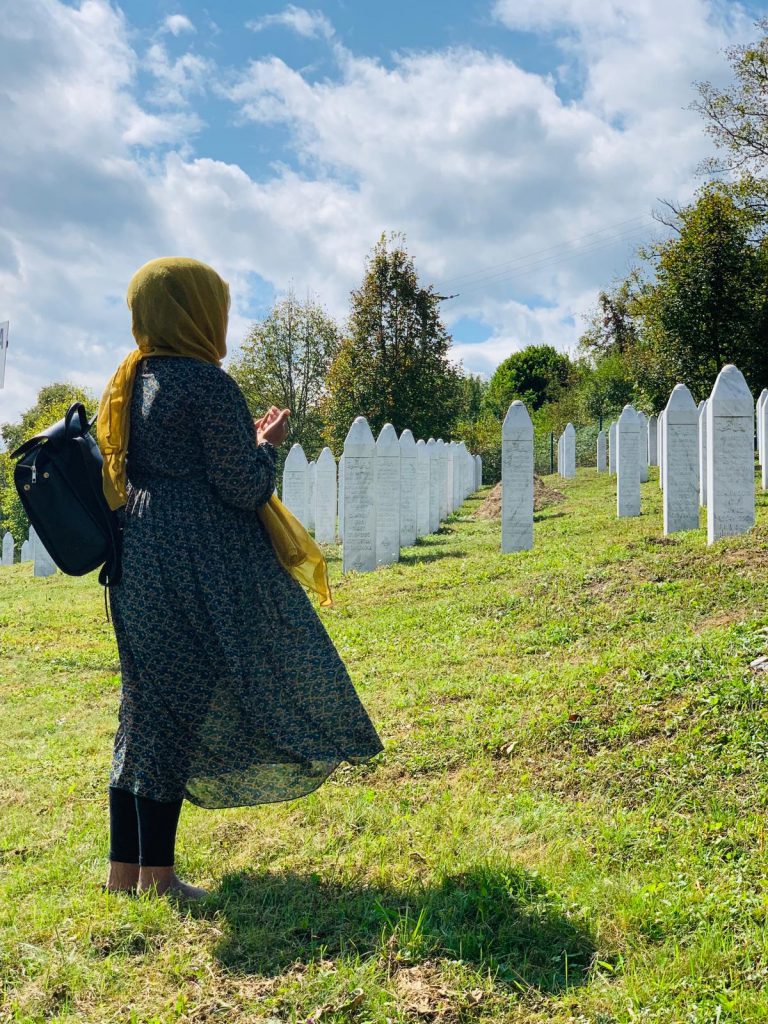 Dževa Avdić also states in her book as a child surviving the war, “My smile is my revenge”, debt is what we have. The cries of the Mothers we visited echo in my heart and soul, particularly Munira who lost her son, who was killed by her own neighbour and whose son she had breastfed. She said “I go to sleep crying and wake up in pain” this is my reality. Finding my sons remains (she has only ever found 2 small bones) and creating awareness is my life’s mission.
Dževa Avdić also states in her book as a child surviving the war, “My smile is my revenge”, debt is what we have. The cries of the Mothers we visited echo in my heart and soul, particularly Munira who lost her son, who was killed by her own neighbour and whose son she had breastfed. She said “I go to sleep crying and wake up in pain” this is my reality. Finding my sons remains (she has only ever found 2 small bones) and creating awareness is my life’s mission.
Debt is what I have and I will do everything in my power to expiate that debt and bring some ease to the engulfed hearts of these mothers and peace to the souls that have left us.
- Rukia
Srebrenica 2019
Discovering Srebrenica
Day One
On the flights over I was looking forward to gaining more knowledge about the country and its history. At the same time, I was nervous and a little anxious about meeting the Mothers of Srebrenica. With being a mother myself I dreaded what truths they had to tell about their pain and suffering.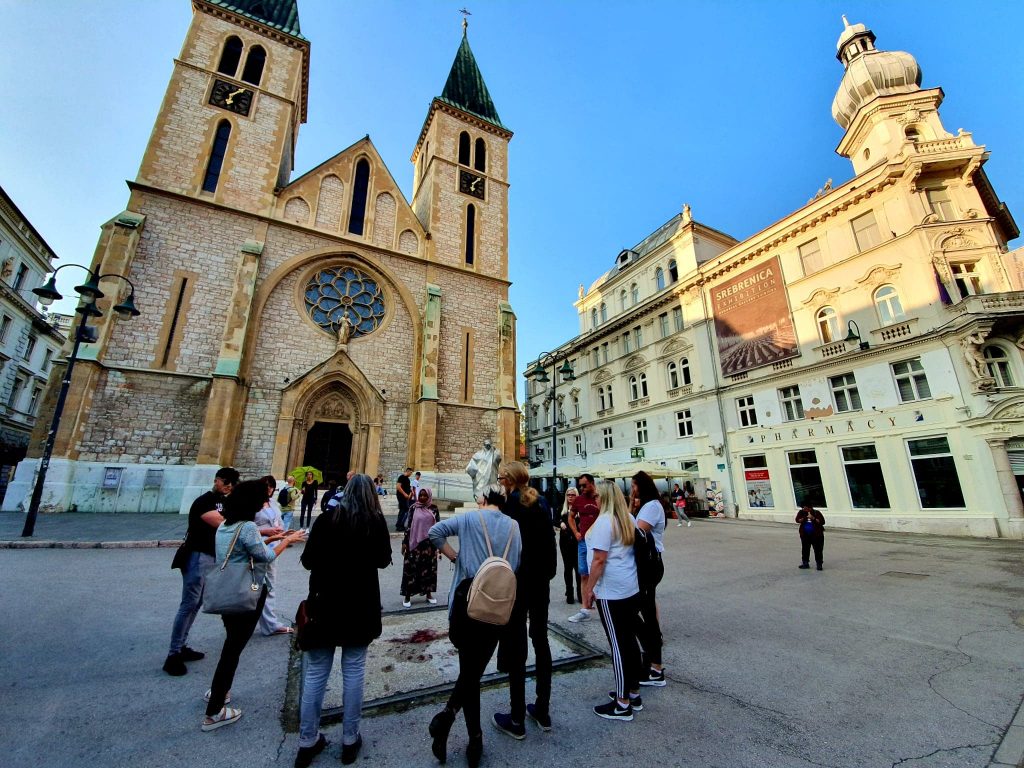
On arrival, I couldn’t believe what a beautiful green country Bosnia and Herzegovina were. I think most of us expected it to be more poverty-stricken and run down. Walking around Sarajevo town you couldn’t help but notice the modern buildings that overshadow the surrounding rustic old buildings slightly dishevelled by time which makes them more glorious to look at. For period of time you forget why your there because you are taking in the beautiful sights until you glance up and see; a chimney breast covered in bullet holes, you turn around and see a statue of a man who called his son to his death, you look down and see the roses of Sarajevo in the ground where a shell landed. So many memories of pain for such a beautiful country.
Day Two
It was an early start as we had over two hours to travel to Srebrenica. Walking through the graveyard gates instantly I had a feeling of sadness washed over me. Looking in all direction was either name of people who died or rows and rows of gravestones. Looking at the list of names of the people who died and sometimes 2 or 3 columns had the same family name. In the graveyard, we came across two elderly men. Aida spoke to them and they had come to visit family graves. also, they had come to visit a friend’s grave who worked in the factory with them. He was the only man in the graveyard buried there who wasn’t a Muslim. However, it was the mother’s wishes as he was surrounded by his friend in life and so he should be in death.
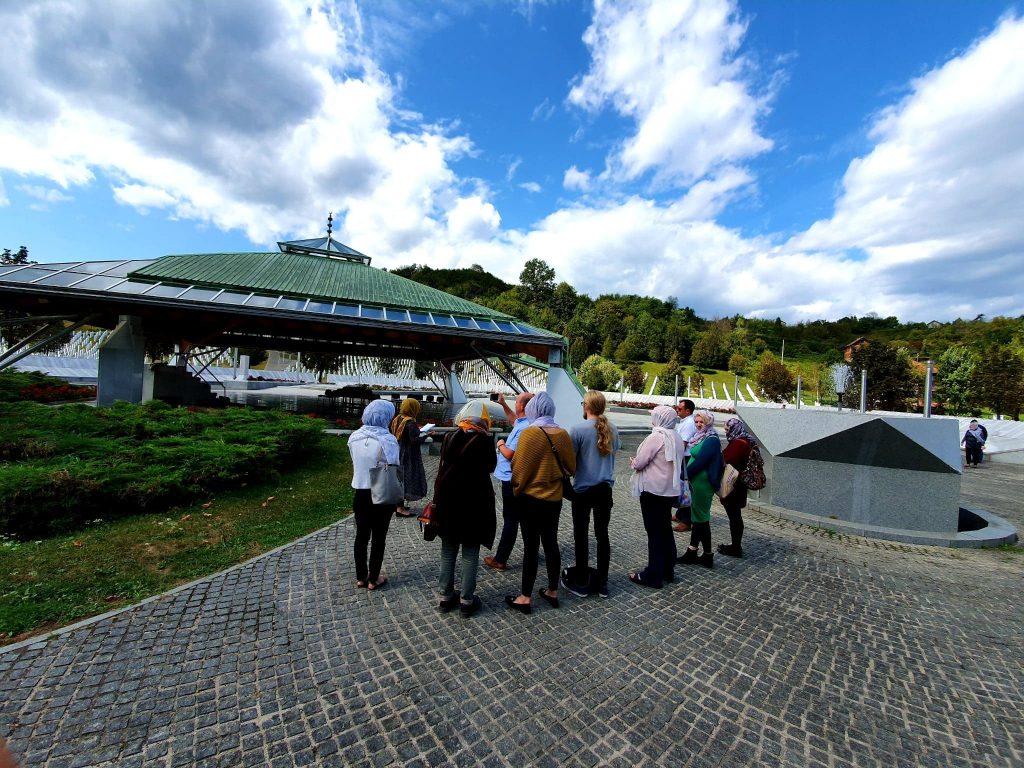 We went to have a tour of the Potocari Memorial Centre. sitting down in front of 6 big televisions the video began to play. images and video clips came on of people been separated from family. People crying and not knowing where to go. Then this clip came on and I will never forget it as long as I live. 6 men in the back of a truck one got kicked in the face, all had their hands tied behind their backs. They were made to get out of the truck and made to walk to a spot and you saw four of the men getting in shot in cold blood. Writing came on the screen four out of the six men were killed. I thought for a second, yes, they ran off and we free somehow. Then the video begins to play again the other two were made to carry the dead man to the place where they were going to be burred and then they were shot too. By this time, I was crying silently. I just could believe how I had been so naive to think that they would have escaped or that they might have been saved. After all, I was learning about the genocide that had happened and there is not going to be any happy endings.
We went to have a tour of the Potocari Memorial Centre. sitting down in front of 6 big televisions the video began to play. images and video clips came on of people been separated from family. People crying and not knowing where to go. Then this clip came on and I will never forget it as long as I live. 6 men in the back of a truck one got kicked in the face, all had their hands tied behind their backs. They were made to get out of the truck and made to walk to a spot and you saw four of the men getting in shot in cold blood. Writing came on the screen four out of the six men were killed. I thought for a second, yes, they ran off and we free somehow. Then the video begins to play again the other two were made to carry the dead man to the place where they were going to be burred and then they were shot too. By this time, I was crying silently. I just could believe how I had been so naive to think that they would have escaped or that they might have been saved. After all, I was learning about the genocide that had happened and there is not going to be any happy endings.
Meeting the mothers of Srebrenica was such an amazingly humbling experience. Their hospitality and food were amazing needless to say I have two helpings of food on offer. Listening to the mother talk about the suffering of the innocent and that she lost her husband and son was so sad. she said that she fed the baby of the man who killed her son because the baby didn’t have a choice who his parents as he was just an innocent too. The more I listened the more choked up I got. I asked a question I asked how? How she goes on? How does she get out of bed and keep living? Her husband and one of her sons are gone. How could she keep fighting the fight for justice? Because if it was me, I don’t think I could have carried on living. As the question was translated her eyes filled up and she started to cry. The mother’s response was basically that she carried on because she wants justice and she wants to help fight for it and that she has another son and grandchildren. that was what I caught of it cause, to be honest, I was looking into her eyes at the pain-filled tears rolling down her face. I left there thinking what amazing bunch of ladies they are to be fighting through their pain to help ease the pain of others.
That night in the hotel I couldn’t help but think how horrible I was to have made the mother cry. How insensitive the question was? it took me ages to fall as sleep with the question that I asked and picturing the tears trickling down the mother’s face on replay in my mind. Thought of the day was why do we stand and fight? To create only pain and suffering? When if we sat and listened to understand there would be no need.
Day Three
We visited two museums, first was Valter Brani Sarajevo this was based on the story of Vladimir Peric, called Walter, a partisan fighter from World War 2. They have some interesting props in there from the movie and there were scenes set up one was of a watch shop that if you want and asked for the right watch and gave the right password you would be allowed into another room. This was said to happen for real and the man who owned a watch shop ended up getting killed himself by the German soldiers. We were told that at the end of the movie Von Dietrich Muses finally realised why he never managed to defeat his nemesis, Walter, standing on a hill he points at Sarajevo below and remarks:’ You See that City? That is Walter!’ This indeed sent a message of unity consistent with the official politics of the multi-ethnic state of Yugoslavia. Still, to this day people will say Walter will come to save us. Sadly, Walter was killed the day Sarajevo was liberated – 6/4/1945.
 War Childhood Museum was interesting but so sad. The Museum had lots of things that people have sent in from when they were a child at the time of the war in Sarajevo from all the pieces were interesting but a few really stood out to me. One was from a sister called ‘My sister Nina’. This was about a little girl aged 12 who wanted to keep a diary throughout the war. Her parents couldn’t get her one until 1995 when her mum brought her a notebook from work. She wrote “Damn you, why are you killing our souls, which only exist to love? To love peace, to love play, to love happiness… but then again, I won’t curse you because you are also the fathers of children who love peace and happiness…” She was wounded on August 27, 1995, she passed away a few days later. The other was titled ‘A sniper killed my Brother’. It said that: My late Brother was always drawing something, even by candle light. He never rested. He was an artist.’ Amel was killed on May 3, 1995. It was during the period of truce. He was killed by a sniper coming from the Spicasta Stijena, located above Sarajevo. These really got to me because I have a sister and a brother, and it could have easily been me writing about mine. It made me think not only life is so precious but our loved ones too.
War Childhood Museum was interesting but so sad. The Museum had lots of things that people have sent in from when they were a child at the time of the war in Sarajevo from all the pieces were interesting but a few really stood out to me. One was from a sister called ‘My sister Nina’. This was about a little girl aged 12 who wanted to keep a diary throughout the war. Her parents couldn’t get her one until 1995 when her mum brought her a notebook from work. She wrote “Damn you, why are you killing our souls, which only exist to love? To love peace, to love play, to love happiness… but then again, I won’t curse you because you are also the fathers of children who love peace and happiness…” She was wounded on August 27, 1995, she passed away a few days later. The other was titled ‘A sniper killed my Brother’. It said that: My late Brother was always drawing something, even by candle light. He never rested. He was an artist.’ Amel was killed on May 3, 1995. It was during the period of truce. He was killed by a sniper coming from the Spicasta Stijena, located above Sarajevo. These really got to me because I have a sister and a brother, and it could have easily been me writing about mine. It made me think not only life is so precious but our loved ones too.
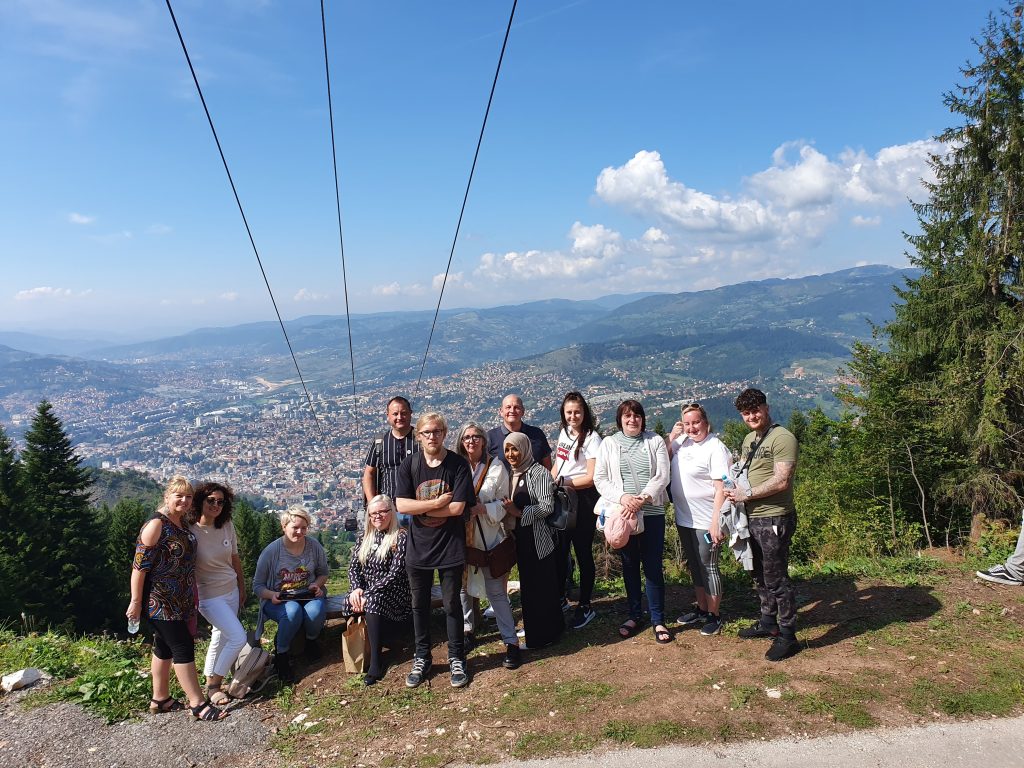 Riding in the cable cars looking over Sarajevo made me think. In some ways, they have done so well to overcome all the heartache caused by genocide, such as rebuilding their lives and country. Although if I could look into their hearts I bet they wouldn’t be so beautiful as the view I am seeing now.
Riding in the cable cars looking over Sarajevo made me think. In some ways, they have done so well to overcome all the heartache caused by genocide, such as rebuilding their lives and country. Although if I could look into their hearts I bet they wouldn’t be so beautiful as the view I am seeing now.
Thought of the day: the people are the true heroes in the tales that have been told and deserve to be recognized for that.
Day Four
One last thing to see before setting off home was the Tunnel Museum. We pull up to an old house filled with bullet holes. walking around the back into what would have been the garden, a guide meets us and takes us on a tour. He explains that this house was owned by a lady who let people build a tunnel to help people to go back and forth. In the middle of all this, he begins to tell us that the Tunnel was used to ferry supply’s and even to carry the injured or a pushcart from and to besieged Sarajevo. He shows us on a map of how Sarajevo was surrounded. He began to say that a Serb soldier got arrested and when talking about killing people he said:’ I would get bored have a drink and then decide to kill someone’, and he would choose his victim by which child looked happiest laughing the most and kill them. It was also said that if you paid the soldiers you could go to one of their bases and pick a weapon of your choice and kill someone. This reminded me of a safari but with people, not animals. He also said that they would play mind games and if a parent was walking with a child the sniper would kill the child as it would be more of a torture to the parent than if they themselves were killed. We got to walk down a small part of the tunnel and I’m not the tallest of people standing tall at 5 foot 4 inches and even I had to bend. I could only imagine how hard it would be to walk the full distance of the tunnel without being in pain from just that, let alone anything else that was happening.
This experience had made me think about my life and the things and people I may take for granted. I think going forward I should take every opportunity given to me: LOVE more, LAUGH lots, Never Hate, speak my mind, never hold grudges and always live every day like it’s my last. You never know what tomorrow may bring.
More blogs from Bosnia are to arrive soon. Keep an eye out on our socials

